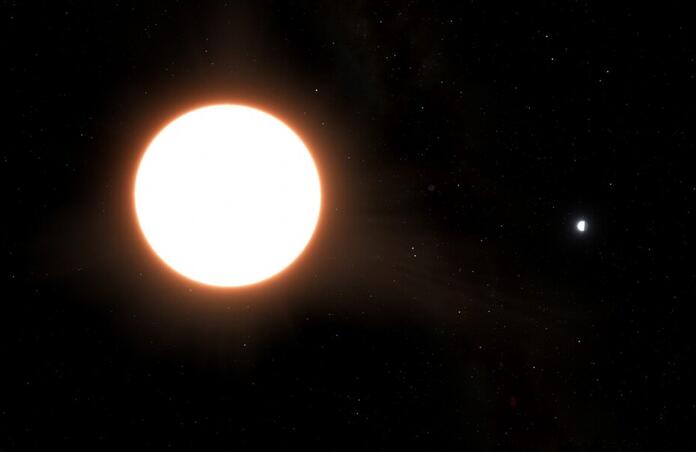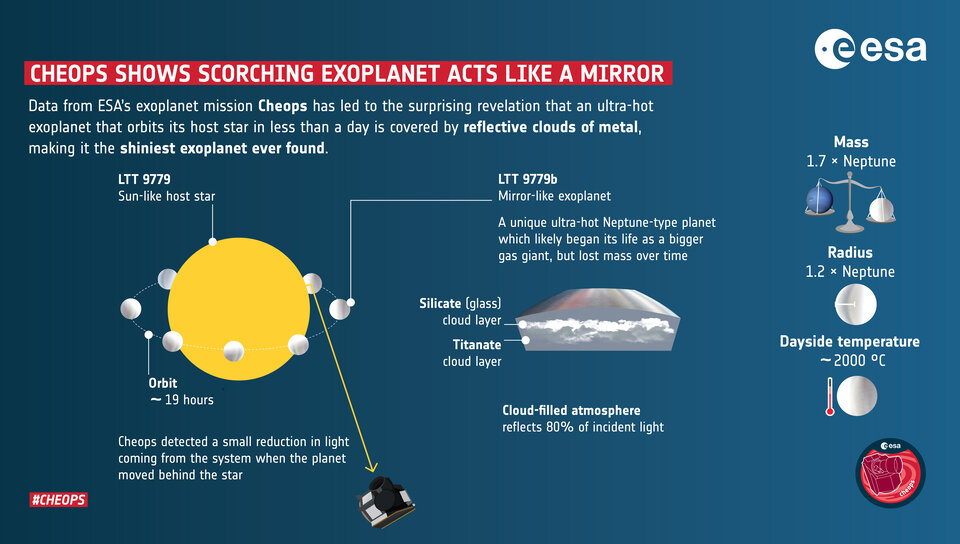Scientists discover most reflective planet yet which 'shouldn't exist'

An exoplanet that acts as a cosmic mirror has been discovered by astronomers, making it the most reflective planet outside our solar system yet. The scorching hot planet, named LTT9779b has a reflective nature due to its metal clouds, which rain drops of titanium.
Located 264 light years away, LTT9779b orbits its star in a rapid 19 hours. The planet is so reflective that it is the first to compete with Venus, whose thick clouds reflect 75% of incident light. The exoplanet reflects 80% of starlight, an extremely large percentage compared to the mere 30% that Earth reflects. The mirror planet is around five times as large as Earth, which also makes it the largest reflective planet discovered.
LTT9779b was discovered by NASA’s TESS mission in 2020. However, its reflective nature wasn’t realised until a follow-up investigation was carried out by ESA’s CHEOPS. The extreme planet is classed as an ultra-hot Neptune due to its high temperatures and similar size to the icy giant.

However, the mirrorlike appearance of the exoplanet was initially puzzling to astronomers. Most planets tend to have low albedos due to their absorptive atmospheres, which prevent light from being reflected. Because of the high temperatures of 2000°C on the planet’s dayside, it was predicted to have a low albedo since clouds of water wouldn’t be able to form. In fact, this temperature is even hot enough to prohibit clouds of metal or glass to exist. “It's a planet that shouldn't exist," says research co-author and Observatory of Côte d'Azur researcher Vivien Parmentier. "We expect planets like this to have their atmosphere blown away by their star, leaving behind bare rock."
The existence of this seemingly impossible planet has encouraged scientists to theorise about how such metal clouds form. "It was really a puzzle until we realized we should think about this cloud formation in the same way as condensation forming in a bathroom after a hot shower," Parmentier added. "To steam up a bathroom, you can either cool the air until water vapor condenses, or you can keep the hot water running until clouds form because the air is so saturated with vapor that it simply can't hold anymore."
The team thinks that the metal clouds and therefore high albedo resulted from an atmosphere that is oversaturated with silicate and metal, the materials being vaporised by the blistering temperatures on the planet's day side, which is tidally locked to face its host star at all times.
Along with its dazzling reflective nature, LTT9779b is part of a group of exoplanets that remain a mystery to astronomers due to the lack of such detections. Planets of this size and mass which take close orbits seem to be ‘missing’ from the planets discovered. All other planets found with extremely short orbits of less than a day have either been dubbed as ‘hot Jupiters’, spanning widths 10x that of Earth, or rocky planets smaller than 2x the earth of Earth. This results in a gap of planets between the two groups, also known as the hot-Neptunian desert. LTT9779b fits perfectly within the gap, and its existence may be attributed to its metallic clouds.
"We believe these metal clouds help the planet to survive in the hot Neptune desert," research lead author and Marseille Astrophysics Laboratory scientist Sergio Hoyer said. "The clouds reflect light and stop the planet from getting too hot and evaporating. Meanwhile, being highly metallic makes the planet and its atmosphere heavy and harder to blow away."
In the coming years, LTT9779b will likely be a target of interest for the Webb and Hubble telescopes, hoping to uncover more about the nature of the exoplanet and its highly reflective clouds.
--
Cover image: Ricardo Ramírez Reyes (Universidad de Chile)
Journal source: S. Hoyer et al, The extremely high albedo of LTT 9779 b revealed by CHEOPS, Astronomy & Astrophysics (2023). DOI: 10.1051/0004-6361/202346117
